Sant’Angelo di Roccalvecce, il borgo ridipinto dalle donne
Quando l'urban art invade un piccolo e anonimo borgo dell'Alto Lazio nasce il paese delle fiabe: ecco a voi Sant'Angelo di Roccalvecce.

(English translation below)
Lo chiamano il paese delle fiabe. Eppure fino a quattro anni fa Sant’Angelo di Roccalvecce era uno di quei borghi inespressivi, senza una particolare identità storica o naturalistica, incastonato in un’area, la Tuscia viterbese, che invece è piena di borghi medievali ricchi di fascino architettonico, con mura di cinta, torri, castelli, vicoli tortuosi e case di pietra.
Il paese di Sant’Angelo di Roccalvecce invece no, non aveva niente di tutta questa bellezza. Era, ed è, solo uno sputo di case senza carattere, tirate su, mattone dopo mattone, nel 1700 da pastori transumanti dell’Appennino. Case che poi, nel tempo, sono rimaste in gran parte abbandonate a causa di quella crisi demografica che nella seconda metà del ‘900 ha caratterizzato tutta l’Italia, e che ora sono animate da una popolazione di appena duecento abitanti.
Eppure quattro anni fa, nel 2016, succede qualcosa che cambia per sempre la storia di questo paese senza storia. E il brutto anatroccolo diventa uno splendido cigno.
Tutto nasce dall’iniziativa ardita di Gianluca Chiovelli, professionista romano originario di Sant’Angelo di Roccalvecce che, insieme alla sorella e al cugino, decide di creare l’associazione culturale Acas con la quale mettere in piedi un progetto quasi visionario per quel morso di casette arroccate: creare un museo di murales contemporanei realizzati da street artist sulle pareti spoglie delle case.
Detto, fatto. In meno di un anno il progetto vede la luce e viene inaugurato il 27 novembre del 2017 con un murale dedicato ad Alice nel Paese delle Meraviglie, un’opera realizzata dalla street artist Tina Lo Iodice che introduce il fil rouge di tutto il progetto, le favole. Un’enorme Bianconiglio affianca il dolce viso di Alice, i cui tratti sono quelli di una ragazza del luogo di nome Ambra, con un orologio che segna l’orario delle 11.27, per ricordare in queste cifre la data di inaugurazione di questo progetto a impatto zero.

La strada è tracciata, e da quel momento Sant’Angelo di Roccalvecce si trasforma in un borgo fatato, con decine di giganteschi murales dipinti esclusivamente da artiste donne. Perché riscrivere il quotidiano si può, soprattutto con la fantasia delle migliori street artist italiane: non solo Tina Lo Iodice che realizza ben quattro opere, ma anche Isabella Modanese e Cecilia Tacconi (due studentesse universitarie di Bolzano), Daniela Lai, Layla Xing, SteReal (al secolo Stefania Marchetto, artista milanese), Stefania Capati, Rame 13 (una street artist pisana) per un viaggio in un mondo fantastico, accompagnati da Pinocchio, Aladino, il Piccolo Principe, Hansel e Gretel, gli gnomi dei fratelli Grimm e tutti i più celebri personaggi delle più belle fiabe.
E il paese diventa esso stesso una fiaba tra le fiabe, perché i progetti sono quasi tutti autofinanziati dagli stessi abitanti, come nel migliore dei lieti fini, offrendo agli artisti non solo le pareti da dipingere, ma anche i finanziamenti per l’acquisto dei colori e del materiale occorrente.
Le opere sono realizzate quasi tutte in quarzo plastico e tinta lavabile, ma ci sono poi anche opere in ceramica e pietra, installazioni e sculture, mosaici e bassorilievi per un progetto che diventa un vero museo a cielo aperto.
Non mancano poi altri finanziatori, ristoranti del territorio, aziende vitivinicole, volontari. Il murale di Mowgli il bimbo della giungla è stato finanziato dalla Comunità Europea attraverso il progetto Erasmus Plus.
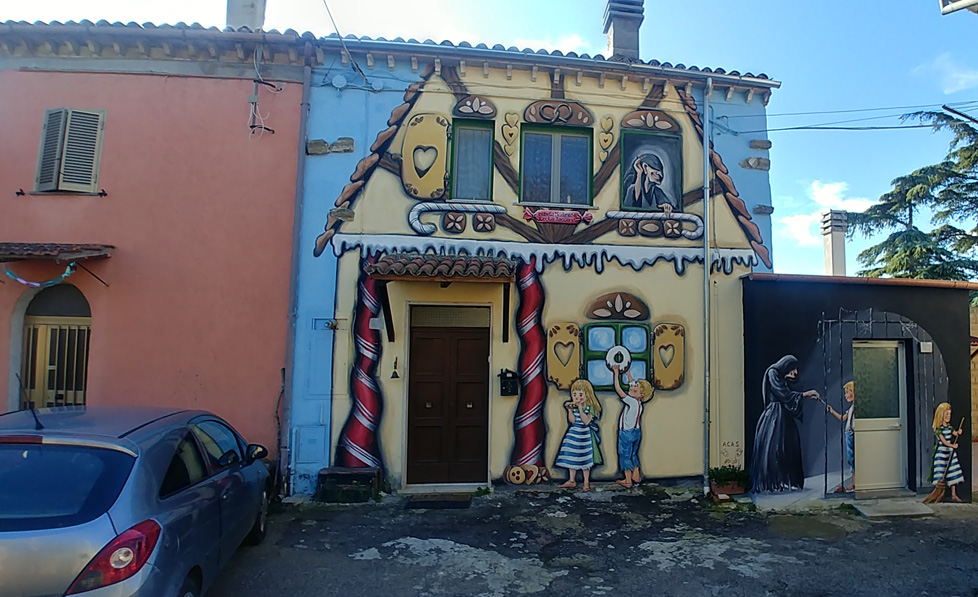
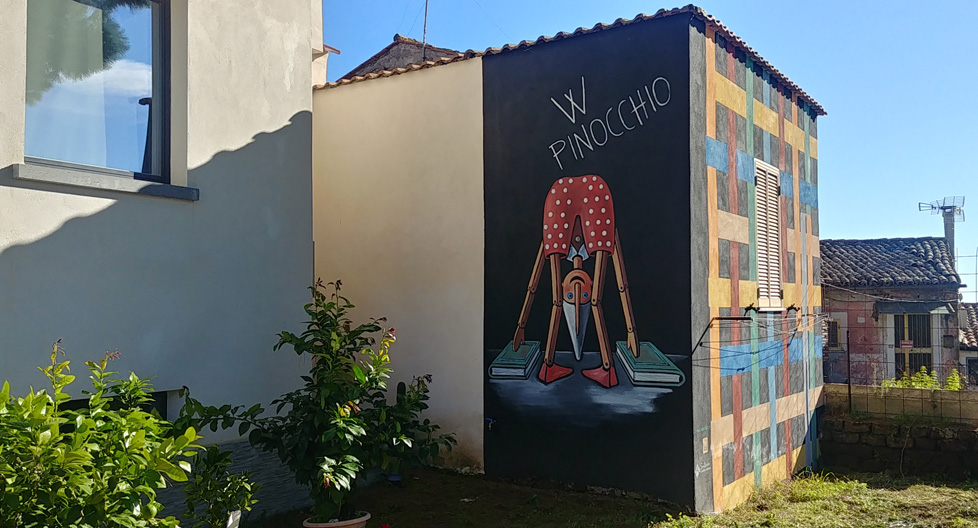
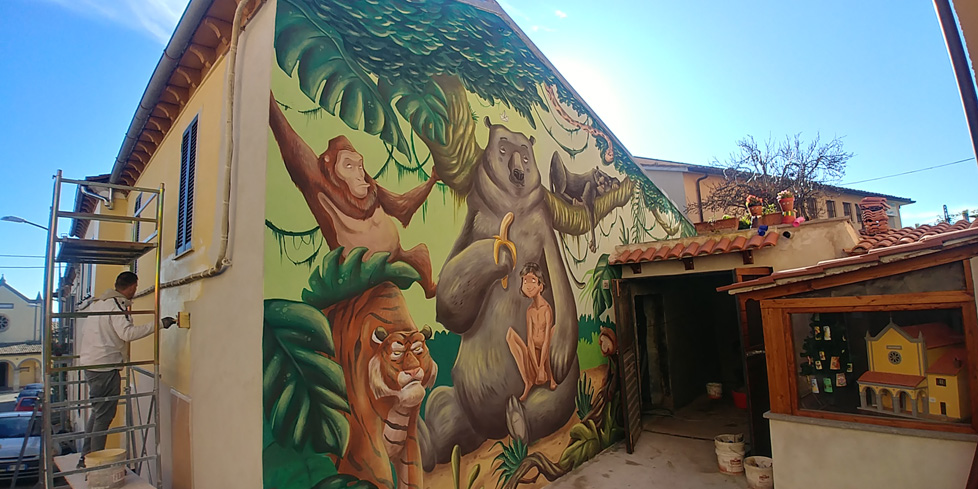
Passeggiando tra i vicoli anonimi di questo borgo si incontrano le sensuali fate di Avalon, una languida piccola fiammiferaia accovacciata a terra nel freddo della notte, un simpatico Brontolo immancabilmente imbronciato, la Fabbrica di cioccolato, Alì Babà e i 40 ladroni, il giro del mondo in 80 giorni, la bella addormentata nel bosco e persino la spada nella roccia, una spada vera intendo, infilata dentro una roccia davanti al suo bellissimo murale, l’unico realizzato non a pennello ma con la tecnica della bomboletta spray.
Molti dei personaggi hanno i volti di abitanti del luogo, Don Chisciotte ha il volto del vicepresidente dell’associazione Acas, e poi tanti ragazzi e ragazze, bambini ed anziani del paese immortalati nei panni di questi eroi delle fiabe. Ma l’opera più struggente è quella di Peter Pan, dipinta con malinconica grazia, nella quale ci colpisce il volto dolcissimo e sorridente di una ragazza che, ci raccontano, viveva a Sant’Angelo di Roccalvecce e scomparve tragicamente nel 2017. Le amiche hanno voluto ricordarla così.
Tra le celebri favole si innesta anche qualche racconto popolare, come la storia della bambina Venella, realmente accaduta nella zona intorno agli anni ’30, una vicenda poi a lungo narrata dai cantastorie e tramandata di generazione in generazione.
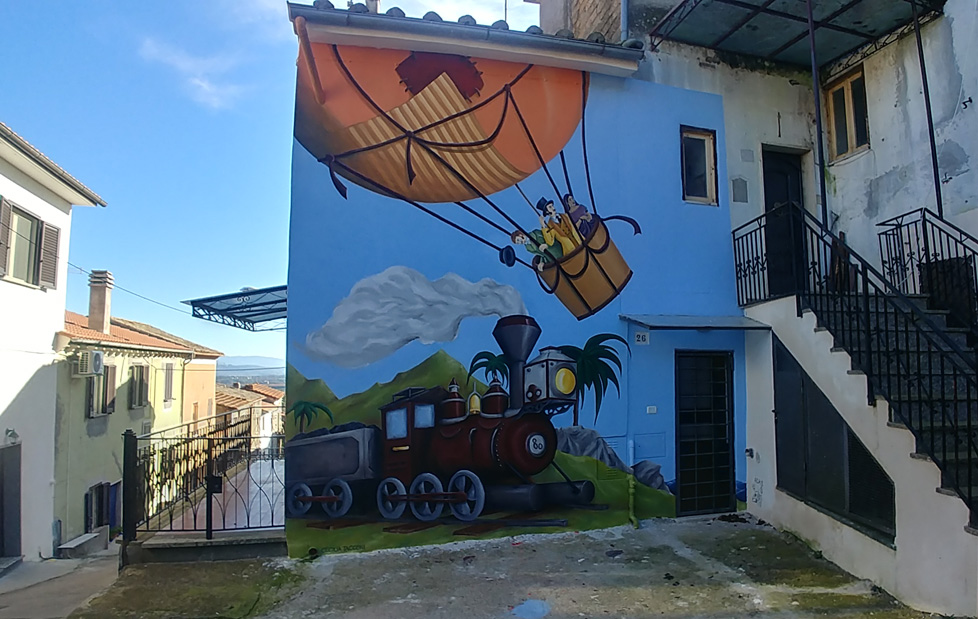
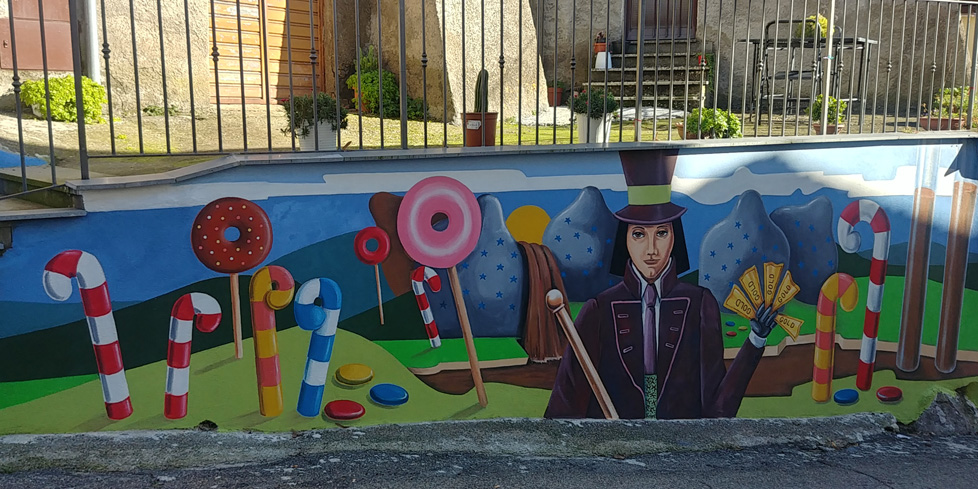
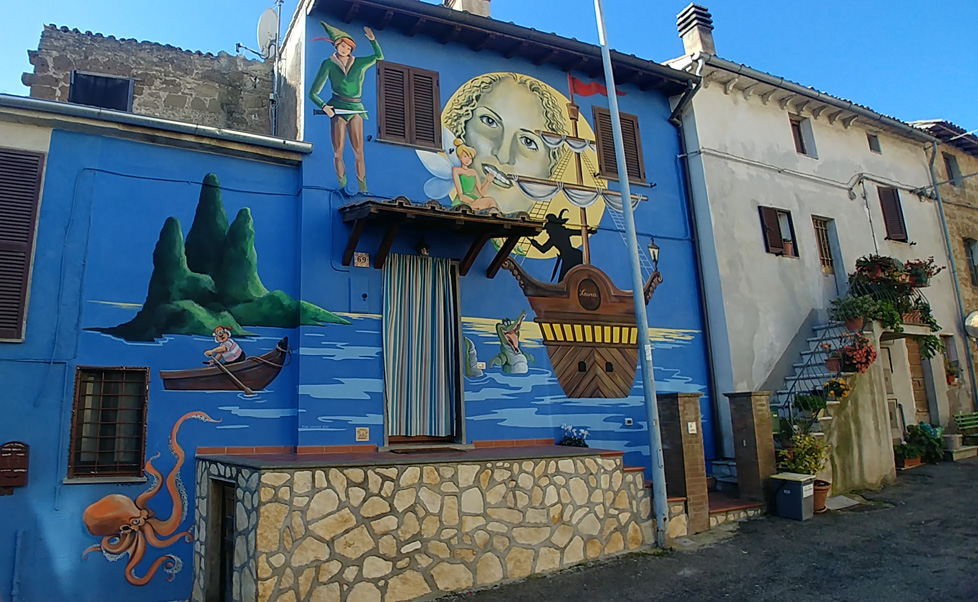
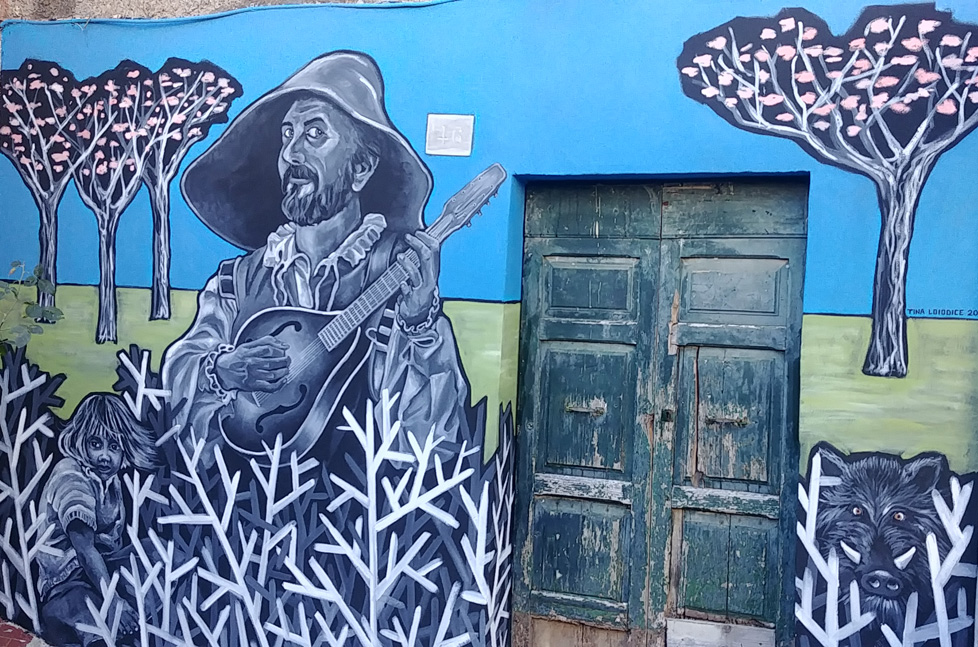
Il progetto ha restituito turgore a tutto il territorio, risvegliando l’artigianato locale, riattivando i contatti tra comuni limitrofi, e soprattutto facendo arrivare centinaia di visitatori e turisti incuriositi e attratti dalla forza evocativa delle opere dipinte.
E così un borgo senza arte né parte si erge a pieno titolo come museo open air, e diventa spazio di commistione tra un territorio bucolico, costellato di splendidi vigneti e ciliegeti, e un’arte espressamente urbana.
ENGLISH VERSION
When urban art invades a small and anonymous village in Upper Lazio, the land of fairy tales is born: here is Sant’Angelo di Roccalvecce.
They call it the land of fairy tales. Yet until four years ago it was one of those inexpressive villages, without a particular historical or naturalistic identity, nestled in an area, the Tuscia Region, which instead is full of medieval villages with architectural charm, with surrounding walls, towers, castles, winding alleys and stone houses.
The village of Sant’Angelo di Roccalvecce, on the other hand, did not have any of this beauty. It was, and is, just a spit of houses without character, built up, brick by brick, in 1700 by transhumant shepherds of the Apennines. Houses that, over time, have remained largely abandoned due to the demographic crisis that characterized all of Italy in the second half of the 20th century, and which are now animated by a population of just two hundred inhabitants.
Yet four years ago, in 2016, something happened that changed the history of this country without history forever. And the ugly duckling becomes a beautiful swan.
It all stems from the daring initiative of Gianluca Chiovelli, a Roman professional from Sant’Angelo di Roccalvecce who, together with his sister and cousin, decided to create the cultural association Acas with which to set up an almost visionary project for that bite of perched houses: create a museum of contemporary murals made by street artists on the bare walls of the houses.
No sooner said than done. In less than a year the project sees the light and is inaugurated on November 27th 2017 with a mural dedicated to Alice in Wonderland, a work created by street artist Tina Lo Iodice that introduces the fil rouge of the whole project, the tales. A huge White Rabbit flanks Alice’s sweet face, whose features are those of a local girl named Ambra, with a clock that marks 11.27, to remember in these numbers the inauguration date of this project without impact on the environment.
The road is traced, and from that moment Sant’Angelo di Roccalvecce turns into a fairy village, with dozens of gigantic murals painted exclusively by female artists. Because it is possible to rewrite the daily life, especially with the imagination of the best Italian street artists: not only Tina Lo Iodice who creates four works, but also Isabella Modanese and Cecilia Tacconi (two university students from Bolzano), Daniela Lai, Layla Xing, SteReal (born Stefania Marchetto, Milanese artist), Stefania Capati, Rame 13 (a Pisan street artist) for a journey into a fantastic world, accompanied by Pinocchio, Aladino, the Little Prince, Hansel and Gretel, the gnomes of the Grimm brothers and all the most famous characters of the most beautiful fairy tales. And the country itself becomes a fairy tale among fairy tales, because the projects are almost all self-financed by the inhabitants themselves, as in the best of happy ends, offering artists not only the walls that need to be painted, but also the financing for the purchase of colours and the necessary material. The works are almost all made of plastic quartz and washable dye, but there are also works in ceramic and stone, installations and sculptures, mosaics and bas-reliefs for a project that becomes a true open-air museum.
There are also other financiers, local restaurants, wineries, volunteers. The mural of Mowgli the child of the jungle was funded by the European Community through the Erasmus Plus project.
Strolling through the anonymous alleys of this village you will meet the sensual fairies of Avalon, a languid little match girl crouched on the ground in the cold of the night, a nice Brontolo, the Chocolate Factory, Ali Babà and the 40 thieves, Around the world in 80 days, the Sleeping Beauty in the woods and even the Sword in the stone, a real sword I mean, stuck inside a rock in front of his beautiful mural, the only one made not with a brush but with the spray can technique.
Many of the characters have the faces of locals, Don Quixote has the face of the vice president of the Acas association, and then many boys and girls, children and elderly people of the village immortalized in the role of these fairy tale heroes. But the most poignant work is that of Peter Pan, painted with melancholy grace, in which you can admire the sweet and smiling face of a girl who, we are told, lived in S. Angelo di Roccalvecce and tragically died in 2017. The friends wanted to remember her this way.
Among the famous fairy tales, there are also some local stories, such as the story of the little girl Venella, which really happened in the area around the 1930s, a story then narrated for a long time by storytellers and handed down from generation to generation.
The project restored strength to the whole territory, awakening local crafts, reactivating contacts between neighbouring municipalities, and above all attracting hundreds of visitors and tourists intrigued by the evocative power of the painted works.
And so a village without history stands fully as an open-air museum and becomes a space for mingling between a bucolic territory, dotted with splendid vineyards and cherry groves, and expressly urban art.
